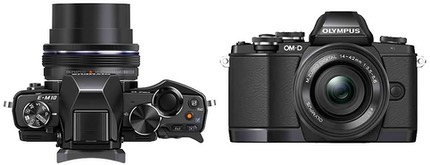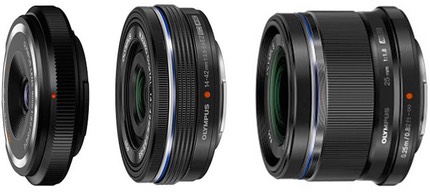
There are no surprises any more when it comes to mirrorless cameras, it appears. Virtually all of the mirrorless camera players are now intentionally leaking information prior to official announcements, apparently in an attempt to get some Internet buzz associated with the product. Yet they still insist that those of us who are on their press lists respect their embargo dates on information. This is marketing micromanagement at its worst. Frankly, I think this practice is now starting to hurt these companies as much as it helps them.
What is the OM-D E-M10? It's the entry model of the OM-D series. Take an E-M5 and tighten in up a bit so that it's a little bit smaller, especially in height, but otherwise recognizable. Stick in some of the E-M1 electronics (including WiFi), simplify the stabilization to a three-axis system, remove the weatherproofing and accessory port, and you've basically got the E-M10. One addition to the E-M5: a built-in flash; it also gets a slightly better rear LCD and the adaptive brightness viewfinder technology from the E-M1. With perhaps the exception of the stabilization and/or weatherproofing, the E-M10 is arguably a better choice of camera for most people than the E-M5, which Olympus is still selling and just updated with a new firmware release. The E-M10 does just enough of an undercut of the E-M5 that it gets harder to sell the older model that's probably on its way out. That's especially true given the US$700 body-only price (US$800 with the older collapsing zoom kit lens).
But let's stick to the new camera itself for a moment. The E-M10 uses the current (E-M1) imaging engine, and Olympus hasn't changed their focus system or EVF so the E-M10 should be as good as the other OM-D models when it comes to image quality parameters (though I'll have a caveat in a moment). A new grip option is available, but it isn't a power grip (grip with room for battery). One interesting point that shows Olympus is thinking right is that GPS support is optional via your smartphone. Finally a company that understands that you don't have to duplicate all electronics but can take advantage of what a customer likely has already with them.
I mentioned a caveat. One source I highly trust who's been able to shoot with and evaluate images from the camera reports "[The E-M10 is] overprotecting highlights. In some cases the E-M10 underexposes two stops before even slightest amount of pixels are saturated." I hope my source is wrong, but he's never been before. This is an old nemesis I've hated since it first appeared back in the late 80's: the camera makers are making decisions about the likely type of shooter and then adjusting things that shouldn't probably be adjusted. Nikon has long had a metering difference between their consumer DSLRs and pro ones, and now it appears that Olympus is joining the party. The premise behind this kind of adjustment is that "the consumer is shooting JPEGs so we want to protect against highlight blowout and increase saturation because they like saturated JPEGs; the pro shooter is taking raw images and knows how to use an exposure meter."
Now, on the one hand, this is essentially ETTR (expose to the right) in a mild form, and ETTR is something we've been asking for. If you know that a camera is doing that, then you can proceed accordingly. But to disguise it in the exposure meter, which we want to be accurate and predictable, isn't a good choice, I think. Just give us an ETTR mode and select it for JPEG shooters that pick Auto settings.
The camera is available in black only or silver on black, and should be available in March.
Along with the camera, Olympus announced three new "lenses" or m4/3. Lenses was in quotes, because one of the new products is another in the lens cap lens series.

The 9mm f/8 Body Cap Lens (left) is a fixed aperture quasi fisheye lens. This US$100 product is slim like a body cap, but incorporates a 5-element lens in the middle that produces 140° images. The second lens (middle) is the new collapsible kit lens, a 14-42mm f/3.5-5.6 optic that is as small as any collapsing zoom I've yet seen (1" in collapsed form). At US$350 it's a bit pricey for a kit zoom type lens, but probably still worth having in your kit, as you get a very versatile lens in a very small package. Finally, the US$300 25mm f/1.8 (right) is a fast normal lens that's small and light and plugs a hole in Olympus' excellent prime lineup.
Final comment: the one thing that strikes me from the O-M10 announcement is that Olympus has finally positioned themselves for the casual DSLR user. In many ways, the Pen bodies are rendered pointless by the E-M10, especially the E-P5. The big DSLR buying range is US$500-800 with kit lens, and Olympus is finally nestled back in that range with a competent, well-rounded, and feature rich product. The small size is going to appeal to the D3300/D5300 type of user, and this is a much more reasonable way to take on the Canon/Nikon DSLR duopoly than US$1000+ bodies.
What's problematic for Olympus still is the menu complexity. There's going to be a lot of E-M10 shooters just leaving the camera in defaults, I think, because diving into the menus requires an exhausting and time-consuming process to get any strong benefits. Pity that Olympus hasn't addressed this issue, which has been present pretty much since the E-P1 first appeared last decade.
Support this site by purchasing from this advertiser:
